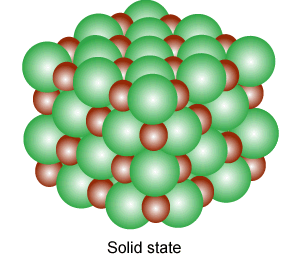Atoms of metals x, y, and z form face-centered cubic (fcc) unit cells of edge length Lx, body-centered cubic (bcc) unit cells of edge length Ly, and simple cubic unit cells of edge length Lz, respectively. If rz =\(\sqrt{\frac{3}{2}}\)ry ; ry = \(\sqrt{\frac{8}{3}}\)rx ; Mz = \(\frac{3}{2}\) My and MZ = 3Mx, then the correct statement(s) is(are)[Given: Mx, My and Mz are molar masses of metals x, y, and z, respectively. rx,ry, and rz are atomic radii of metals x, y, and z, respectively.]
- Packing efficiency of a unit cell of x> Packing efficiency of a unit cell of y > Packing efficiency of a unit cell of z
- Ly > Lz
- Lx > Ly
- Density of x > Density of y
The Correct Option is A, B, D
Solution and Explanation
Given, \(r_z=\frac{\sqrt3}{2}r_y\) and \(r_y=\frac{8}{\sqrt3}r_x\)
\(\therefore\, r_z=\frac{\sqrt3}{2}\times\frac{8}{\sqrt3}r_x=4r_x\)
\(M_z=\frac{3}{2}M_y\)
\(M_z=3M_x\)
\(\therefore M_y=2M_x\)
Packing efficiency FCC>BCC>SC
Packing efficiency unit cell x>y>z
In the FCC unit cell, \(\sqrt2L_x=4r_x\)
\(\Rightarrow L_x=2\sqrt2 r_x\)
\(\therefore \sqrt3l_y=4r_y\Rightarrow L_y=\frac{4}{\sqrt3}r_y=\frac{4}{\sqrt3}\times\frac{8}{\sqrt3}r_x=\frac{32}{3}r_x\)
\(L_y=\frac{32}{3}r_x\)
\(\therefore\,l_z=2r_z\)\(=2\times4r_x=8r_x\)
\(l_x=2\sqrt2r_x\) and \(l_y=\frac{32}{3}r_x\)
\(\therefore l_z=8r_x\)
\(\therefore\,l_y>l_z>l_x\)
density of x = \(d_x=\frac{zM_x}{(L_x)^3N_A}=\frac{4\times M_X}{(2\sqrt2)r_x)^3\times N_A}=\frac{M_X}{4\sqrt2 r^3xN_A}\)
density of y = \(d_y=\frac{zM_y}{(L_y)^3N_A}= \frac{2\times2M_X}{(\frac{32}{3}R_X)^3N_A}=\frac{108M_X}{32768r^3_xN_A}\)
\(\therefore\) density of x > density of y
Top Questions on The solid state
- A metal crystallizes in simple cubic lattice. The volume of one unit cell is \( 6.4 \times 10^{-7} \, \text{pm}^3 \). What is the radius of the metal atom in pm?
- AP EAPCET - 2025
- Chemistry
- The solid state
- A metal crystallises in two cubic phases, fcc and bcc with edge lengths 3.5 Å and 3 Å respectively. The ratio of densities of fcc and bcc is approximately
- TS EAMCET - 2025
- Chemistry
- The solid state
- How many kinds of Bravais lattice are possible in a crystal?
- Bihar Board XII - 2025
- Chemistry
- The solid state
- The percentage of free space in a body-centred cubic unit cell is
- Bihar Board XII - 2025
- Chemistry
- The solid state
- Which of the following is not a crystalline solid?
- Bihar Board XII - 2025
- Chemistry
- The solid state
Questions Asked in JEE Advanced exam
The center of a disk of radius $ r $ and mass $ m $ is attached to a spring of spring constant $ k $, inside a ring of radius $ R>r $ as shown in the figure. The other end of the spring is attached on the periphery of the ring. Both the ring and the disk are in the same vertical plane. The disk can only roll along the inside periphery of the ring, without slipping. The spring can only be stretched or compressed along the periphery of the ring, following Hooke’s law. In equilibrium, the disk is at the bottom of the ring. Assuming small displacement of the disc, the time period of oscillation of center of mass of the disk is written as $ T = \frac{2\pi}{\omega} $. The correct expression for $ \omega $ is ( $ g $ is the acceleration due to gravity):

- JEE Advanced - 2025
- Waves and Oscillations
- Consider the vectors $$ \vec{x} = \hat{i} + 2\hat{j} + 3\hat{k},\quad \vec{y} = 2\hat{i} + 3\hat{j} + \hat{k},\quad \vec{z} = 3\hat{i} + \hat{j} + 2\hat{k}. $$ For two distinct positive real numbers $ \alpha $ and $ \beta $, define $$ \vec{X} = \alpha \vec{x} + \beta \vec{y} - \vec{z},\quad \vec{Y} = \alpha \vec{y} + \beta \vec{z} - \vec{x},\quad \vec{Z} = \alpha \vec{z} + \beta \vec{x} - \vec{y}. $$ If the vectors $ \vec{X}, \vec{Y}, \vec{Z} $ lie in a plane, then the value of $ \alpha + \beta - 3 $ is ________.
- If $$ \alpha = \int_{\frac{1}{2}}^{2} \frac{\tan^{-1} x}{2x^2 - 3x + 2} \, dx, $$ then the value of $ \sqrt{7} \tan \left( \frac{2\alpha \sqrt{7}}{\pi} \right) $ is.
(Here, the inverse trigonometric function $ \tan^{-1} x $ assumes values in $ \left( -\frac{\pi}{2}, \frac{\pi}{2} \right) $.)- JEE Advanced - 2025
- Integral Calculus
Let $ a_0, a_1, ..., a_{23} $ be real numbers such that $$ \left(1 + \frac{2}{5}x \right)^{23} = \sum_{i=0}^{23} a_i x^i $$ for every real number $ x $. Let $ a_r $ be the largest among the numbers $ a_j $ for $ 0 \leq j \leq 23 $. Then the value of $ r $ is ________.
- JEE Advanced - 2025
- binomial expansion formula
- The total number of real solutions of the equation $$ \theta = \tan^{-1}(2 \tan \theta) - \frac{1}{2} \sin^{-1} \left( \frac{6 \tan \theta}{9 + \tan^2 \theta} \right) $$ is
(Here, the inverse trigonometric functions $ \sin^{-1} x $ and $ \tan^{-1} x $ assume values in $[-\frac{\pi}{2}, \frac{\pi}{2}]$ and $(-\frac{\pi}{2}, \frac{\pi}{2})$, respectively.)- JEE Advanced - 2025
- Inverse Trigonometric Functions
Concepts Used:
Solid State
Solids are substances that are featured by a definite shape, volume, and high density. In the solid-state, the composed particles are arranged in several manners. Solid-state, in simple terms, means "no moving parts." Thus solid-state electronic devices are the ones inclusive of solid components that don’t change their position. Solid is a state of matter where the composed particles are arranged close to each other. The composed particles can be either atoms, molecules, or ions.

Types of Solids:
Based on the nature of the order that is present in the arrangement of their constituent particles solids can be divided into two types;
- Amorphous solids behave the same as super cool liquids due to the arrangement of constituent particles in short-range order. They are isotropic and have a broad melting point (range is about greater than 5°C).
- Crystalline solids have a fixed shape and the constituent particles are arranged in a long-range order.